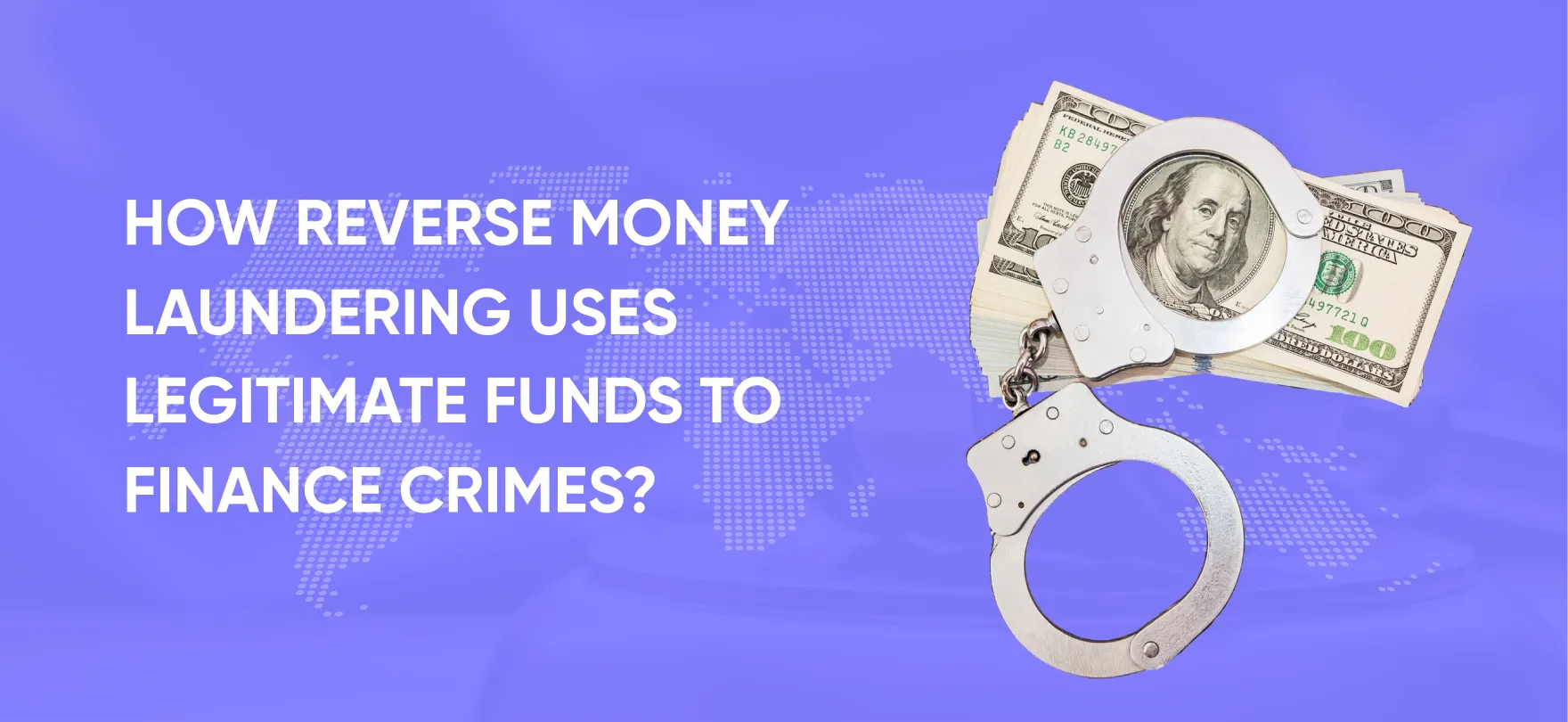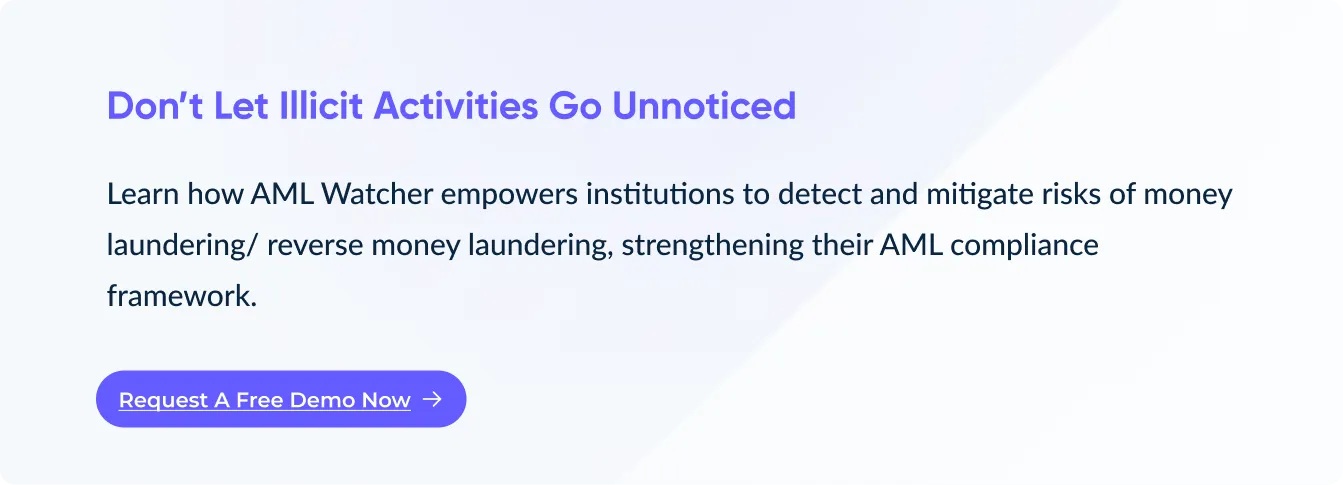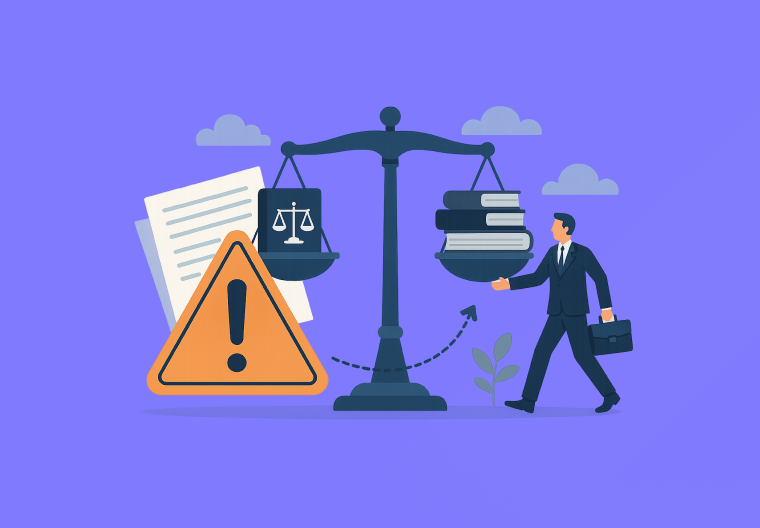
How Reverse Money Laundering Uses Legitimate Funds to Finance Crimes?
Whenever anyone mentions the term “financial crimes,” the first thing that comes to mind is often “money laundering.”
Human psychology dictates that our minds automatically start searching for the underlying cause when an issue arises.
This is also true for money laundering. To combat money laundering effectively, we need to identify the source of the funds, which emphasizes the importance of tracking the origin of dirty money.
What if those sources or origins of funds turn out to be legal but still promote illegal activities? Have you thought that criminals could keep legitimate money and use it for financial crimes?
Yes, they can do this; it is called “Reverse Money Laundering”
Since the mid-1980s, Money Laundering in legislation has been categorized as a “criminal offense” in most developed countries.
From country to country, the legislation has been carrying variations; as observed, some have laws that are simple and only focus on “laundered proceeds of drug trafficking.”
Diverse Regulatory Frameworks For Tackling Money Laundering
For some AML legislations, financial transactions that are intended to conceal the “origin of funds” are considered to be under the “crime category.”
The severity of penalties varies according to the financial crimes committed under different laws. Some laws only impose “imprisonment” as a penalty.
Others impose financial penalties or kind of “the confiscation of laundered property or property involved in money laundering.”
There was a common factor in all these AML laws focusing on “proceeds of already committed crimes.”
What if the whole process has shifted, and now clean money is used to conduct a crime in the future?
Let’s explore a new perspective on money laundering by understanding the dark realities of “Reverse Money Laundering ” and its hidden threats to the financial sector.
What is Reverse Money Laundering
Reverse money laundering (RML) initiates with legitimate funds and utilizes it to “fuel illicit activities” such as Terrorist financing, Drug trafficking, and corruption strategies.
Traditional money laundering turns illicit gains into assets that look legitimate, but reverse money laundering poses an even greater risk to international financial institutions.
Financial institutions and regulatory agencies around the world face serious difficulties as a result of this sophisticated financial crime, which involves transforming legally earned monies into untraceable assets for illicit purposes.

Legitimate Funds Are Obtained From Legal Sources
- Charitable groups that raise donations to benefit humanity
- Business organizations that make profits from doing legitimate business
- Governments provide financial aid for particular schemes or projects
- Funds are collected using online platforms by Crowdfunding techniques for individual or business goals
- Salaries that are earned through business agreements or regular employment
- Funds received as a result of the inheritance process.
- Money is obtained from winning the lottery or through legal gambling
- Compensations gained by legal sources in the form of insurance payouts
Redirection Of Legitimate Funds Into Illegal Activities
Intentionally legitimate money is introduced to fuel illicit activities and convert it into dirty money, which is challenging to identify. Illegal activities are financial crimes such as “Terrorist financing, Drug trafficking, and Corruption schemes.”
When these legally obtained funds are entangled in illegal operations, their traceability becomes a huge challenge for authorities as they are layered enough to make it difficult to detect.
Reinvestment makes it challenging to identify to the point that their legitimate sources can be accessed.
Typically, financial institutions focus on identifying dirty money that is being converted into clean money by “monitoring unusual transaction patterns and implementing various anti-money laundering (AML) measures.”
However, Reverse Money Laundering bypasses these steps, using clean money intended for illicit activities from the outset.
Techniques of Reverse Money Laundering
Common techniques of Reverse Money Laundering are described below:
Trade-Based Money Laundering (TBML) in Reverse
Authorized businesses frequently produce fake invoices or deliberately lie about the value of goods to inflate asset prices in Trade-Based Money Laundering. This practice reinvests excess funds in illegal activities, effectively financing illicit operations.
Over Invoicing
Businesses create fake invoices by inflating the prices of goods or services beyond their actual value. The buyer pays the “inflated invoice” using legitimate funds, and the excess amount appears as authentic or “legitimate” income for the seller.
The excess funds can be reinvested into illicit activities such as “financing terrorism operations, bribery, or organized crime.” This will create a shield for criminal groups, as they can finish their illicit activities without raising any “suspicion” and putting a mask on their involvement in illegal activities.
A shell company might sell its goods at the double process to launder excess funds for future crimes through “inflated invoices.”
Under-Invoicing
Under-invoicing is the opposite of over-invoicing. It occurs when goods or services are intentionally sold for a price lower than their actual value. Buyers can pay the “reduced invoice amount” publicly, while the difference is typically settled through less detectable channels, such as cash or offshore accounts.
The reason was to hide the actual profits from legal authorities so the business could reinvest these funds into illicit activities or use them for other purposes and skip the detection purpose.
Suppose a company imports pricey electronics but invoices them for less than their actual price to funnel the hidden profit into illegal activities.
Non-Profit Organizations (NPOs) in Reverse Money Laundering
Non-Profit Organizations (NPOs) are often seen as dedicated entities for human welfare and social work to benefit humanity.
However, reverse money laundering techniques know how to exploit these organizations to fund illicit activities.
NPOs are the major players that provide ways to “layer” funds and integrate them into illegal financial systems. Donations that appear legitimate will mask their actual future use in illicit activities, and that’s how illegal activities such as “terrorism financing, drug trafficking, or organized crime” use legitimate funds.
Criminals fraud the people by “Creating Fictitious Causes” by setting NPOs in the name of noble causes such as “disaster relief, education or healthcare” and attracting the donors by appealing with fake slogans and making them understand their money is going to save lives or is going to legitimate efforts.
Once donations are collected, the funds are redirected to accounts of “shell companies or offshore entities.”
NPOs are vulnerable due to the following reasons:
- Smaller nonprofit organizations (NPOs) often lack sufficient resources for adequate financial supervision.
- NPOs collect donations in large volumes during various seminars, events, or campaigns, making it difficult to detect any irregularities.
- Additionally, NPOs collaborate with other organizations globally, complicating the tracking of financial flows across borders.
Loan-Back Schemes
Loan-back schemes are used in Reverse Money Laundering, and the procedure is given below:
- Legitimate funds are provided to shell companies as loans. On paper, it appears to be a typical business loan record. However, shell companies intend to show business losses by intensionally defaulting on for-profit and reporting losses.
- The losses that appear as business expenses are redirected to illicit activities. They often create false loan agreements to produce fake documentation
- Then funnel the money for illegal purposes such as “terrorist financing, corruption and bribery.”
Real Estate Transfers
In this approach, people use “legitimate money” to buy properties, but here is a twist: they might “overpay or underpay” for the property according to their plan to hide their illicit activities.
Here is an example:
- They buy a property for less amount than its actual value and then sell it at a higher price, Or
- They pay more for a property than its actual worth, and the extra money is redirected to someone engaged in “shady business.”
Terrorism Funding and Reverse Money Laundering
Terrorism financing is one of the most significant applications of reverse money laundering, in the contemporary financial environment.
Relationship to Terrorism Funding
Terrorist groups usually use legal financing sources to finance their activities. In contrast to conventional criminal organizations, terrorist organizations frequently obtain funding from private citizens, businesses, and even nonprofits that share their values. To support terrorist acts, these organizations supply legal monies that are then transferred through intricate financial networks.
Real-life Scenarios
9/11 Terrorist Attacks
One of the prominent examples of legitimate funds being used to finance illicit activities is the 9/11 terrorist attacks.
The attackers obtained money through “personal savings, wire transfers, and even legitimate bank accounts” and promoted Reverse Money Laundering.
Their funds came from various sources, including “personal wealth, family savings, charities, and humanitarian aid.” These funds had legitimate sources but were used to plan and commit a brutal terrorist act.
Money was channeled through legitimate banking systems and wire transfers to send to UAE & U.S banks to send to their actual destination in Florida.
Norway Terrorist Attack (2011)
Anders Breivik financed his attack using legitimate funds from his own online business to execute a Terrorist Attack in Norway, resulting in the killing of 77 people.
He used to run an authentic e-commerce business, selling fraudulent diplomas to use the money to buy the “weapons, explosives, and materials” for his attack.
He used reverse money laundering by collecting money through e-commerce businesses and using it for illicit activity. He avoided detection from AML checks until the terrorist attack occurred.
Operation Black Biscuit (Hells Angels)
Undercover agents infiltrated the Hells Angels motorcycle gang from September 2001 to July 2003. One of these agents was “Jay Dobyns”.
Motorcycle groups used to obtain profits from running legitimate businesses such as “bars and merchandise sales” to finance illegal activities such as “drug trafficking and weapons smuggling.”
This represents another example of reverse money laundering, where clean money is used in future financial crimes without raising suspicion and making it harder to trace.
Reverse Money Laundering and Current Legislative Gaps
Although reverse money laundering is not specifically covered by any laws, it can be covered under more general financial crime and anti-money laundering (AML) policies.
These regulations, which are mainly designed to stop money laundering, also cover situations in which legitimate funds are utilized for unlawful purposes.
1. Bank Secrecy Act (BSA) (1970)
U.S. rule that requires financial institutions to keep an eye on transactions and report suspicious activity helps to combat reverse money laundering by tracing the flow of legitimate funds that are being utilized for illegal activities.
2. FATF Recommendations
International norms combat money laundering and terrorist funding, including reverse money laundering, by ensuring due diligence and reporting of suspicious activity involving both legal and illegal funds.
3. Anti-Money Laundering (AML) and Counter-Terrorism Financing (CTF) Laws
National regulations like the UK’s Proceeds of Crime Act 2002 (POCA), The EU’s Anti-Money Laundering Directives, and the U.S. PATRIOT Act govern financial institutions to identify and stop the illicit use of legitimate funds, including reverse money laundering.
4. Proceeds of Crime Act (POCA) 2002 (UK)
UK law permits the confiscation and examination of criminally implicated assets, which can be used to reverse money laundering if legitimate monies are misappropriated for illegal ends.
5. Foreign Corrupt Practices Act (FCPA) (US)
U.S. legislation deals with corruption and bribery, including laws that apply to reverse money laundering when legitimate monies are utilized for corrupt or bribery activities.
Reverse Money Laundering in the USA
However, the US has started recognizing these issues and presenting drafts of legislation related to tracking “Reverse money laundering.”
- The US statute criminalizes the “transmitting, transporting, or transferring money into or out of the USA with the intent to finance another crime, regardless of the money’s origin.”
- The intention behind the spending of funds for illegal purposes is the main factor for the proliferation of financial crimes and cannot mainly depend on the source of funds.
Applications of the Statute
- Victims are convinced to send money out of the country for fake schemes. Even though money was clean, they could still face “money laundering charges.”
- Some individuals transfer money inside and outside the US to make themselves look wealthy and deceive others. They will also face charges for having fraudulent intentions.
- Bringing money inside the US to fund terrorism is a serious crime and will have severe repercussions under this law.
Lack of Domestic Equivalent
- There is “no domestic equivalent of this statute,” which means that any internal movement of funds within the country intended for illicit activities will not be considered a crime.
- They will not be considered money laundering if the funds come from a clean source.
Proposed Legislative Improvements
- Transferring funds exceeding “ $10,000” within the country should be considered illegal if the person knows that money is “criminal proceeds or intended to use in illicit activities.”
- Any transaction involving “currency, wire transfers, real estate, or commodities” that aims to hide or mask the illegal intent of the funds should be penalized.
Equal Treatment of Domestic and Cross-Border Money Movement
- Domestic movements of funds intended to finance criminal activities pose the same dangers and impacts as “cross-border money laundering.”
- Hiding or masking funds for future crimes, such as “terrorism and fraud,” could be more harmful than covering up past crimes, as they have already been committed.
Insights from Section 1960(b)(1)(C)
Targeting Money Remitters
Money laundering Enforcement authorities must target the entities that assist in transactions, such as “money remitters and professional money movers.”
Whether they are working through licensed businesses or working informally, such as “hawala and unofficial casas de cambio.”
These facilitators are key figures in transferring funds. They should be held accountable for their wrongdoings, such as knowing how to fund future financial crimes, regardless of their profession or business.
Legal Frameworks and the USA Patriot Act
The USA Patriot Act has begun recognizing these issues and holding the money transfer businesses accountable for being aware of funds transferred from “illegal sources or used for illicit activities.”
Assets freezing linked with illicit activities discourage future financial crimes; however, the definition of “business” under the law is still unclear. Expanding the definition to involve informal operators “such as street corner money changers or couriers” will close the gaps and cover a broader level.
Shifting Perspectives to Reverse Money Laundering
A forward-looking approach is needed in the AML industry rather than following the same approach towards traditional money laundering, focusing on old methods to trace the origin of illicit funds and identify the “concealment strategies.”
How Can AML Watcher Assist in Combating Reverse Money Laundering?
Reverse Money Laundering (RML) poses particular difficulties in the constantly changing realm of financial crimes, necessitating advanced and automated risk detection and monitoring tools.
AML Watcher can help with this:
Global Data coverage
Using a broad database of global Watchlists, Sanctions & Politically Exposed Persons (PEPs), AML Watcher flags individuals with legal finances suddenly engaging in high-risk activities.
This helps institutions detect possible reverse money laundering or finance illegal activity.
Cross-Jurisdictional Coverage
With global data coverage, AML Watcher ensures that high-risk individuals dealing through regions with weak regulations are screened for potential misuse in reverse money laundering schemes.
Integrated Risk Scoring System
The sophisticated risk assessment system assesses and categorizes possible risks based on multiple factors, including geographic location, PEP status, sanctioned patterns, and media reports to prioritize cases for investigation, and offers a structured approach to detecting reverse money laundering.
Adverse Media Screening
AML Watcher’s adverse media screening flags unfavorable news about a person or organization that may previously transferred lawful wealth into illegal financial activities.
This assists in detecting the misappropriation of funds for illicit activities, such as funding organized crime or terrorism.
Real-Time Data Updates
AML Watcher’s real-time data updates ensure that newly flagged or delisted people or entities are promptly tracked, enabling organizations to spot any changes in risk profiles.
This makes it easier for organizations to keep track of when legitimate funds are used in illegal operations or groups linked to criminal activity.
Customizable Screening Parameters
AML Watcher enables organizations to modify the sensitivity of their AML screening per their unique risk tolerance, by providing configurable risk screening criteria.
This ensures to detection of profiles at a finer level that may include the misuse of legitimate funds for illegal purposes.
Enhanced Due Diligence (EDD)
Institutions can apply enhanced due diligence on high-risk persons or companies that display suspicious behavior.
It is essential for spotting situations in which legitimate funds are being misused, particularly when those involved have intricate financial ties.
We are here to consult you
Switch to AML Watcher today and reduce your current AML cost by 50% - no questions asked.
- Find right product and pricing for your business
- Get your current solution provider audit & minimise your changeover risk
- Gain expert insights with quick response time to your queries












